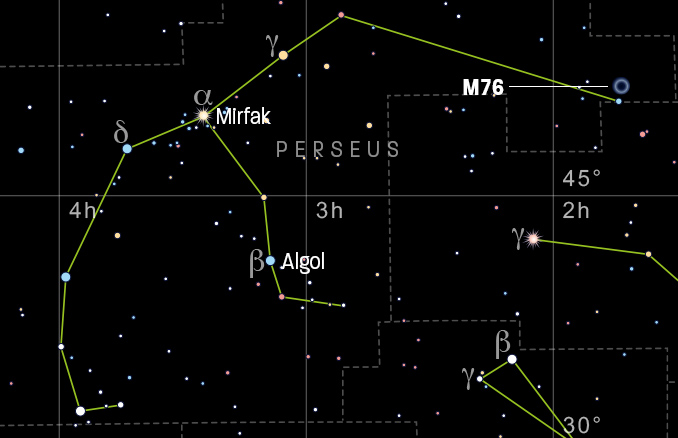
One of only four planetary nebulae to be included in Charles Messier’s famous catalogue, fabulous Messier 76 (NGC 650/651) in Perseus rewards observers and imagers alike with its dramatic two-loop or -lobe appearance, which sufficiently resembles that of summer’s famous Dumbbell Nebula (Messier 27) in Vulpecula for it to go by the nickname the ‘Little Dumbbell’. While M76 is a fair bit fainter and smaller than M27, and has an unwelcome but well-deserved reputation as one of the toughest objects in Messier’s list to observe, a small telescope will identify it and telescopes in the 200–250mm (eight- to ten-inch) class can start to define and detail its distinctive shape and nebulosity.
Messier 76 is a beautiful and dramatic looking planetary nebula living in the magnificent, far-northern constellation of Perseus. Planetary nebulae are the short-lived end-point in the lives of Sun-like stars, their outer layers expelled with the hot core exposed as an ever-cooling white dwarf remnant, its strong ultraviolet radiation ionising the tenuous surrounding envelope and producing an incredible variety of beautiful nebulae.

M76’s hourglass figure
Messier 76 exhibits a remarkable bi-polar structure in deep images, a central, brighter area that has been variously coined a ‘box’, a ‘cork’ or an ‘hourglass’, with two nebulous loops or lobes. One could liken it to a barred spiral galaxy with a whopping central bar with the spiral arms wrapping around it from either end; no sign here of a M57-like ring structure. In many respects this is the joy of planetary nebulae, the uniqueness of each of these objects, with their inherent intricate structures carved out by the interactions of the expelled outer layers of the dying star during its red giant phase with faster-moving, more recently ejected material ploughing into it, producing a series of shock waves.
M76’s appearance is something of an illusion caused by its orientation to Earth; the galaxy analogy is relevant again, as we see some galaxies face-on, some inclined to our line-of-sight, to those spectacularly appearing edge-on. We see the Little Dumbbell from the side, looking at its equator (the angle is 75 degrees); if we could look right down the centre of one of the lobes, it would look like a ring, as is the case with Messier 57. Astronomers have determined that the north-western lobe is pointing our way and the central ‘cork’ is expanding at around 45 km/s.
How far away?
It uncertain how far away M76 is and therefore how big it is. Distances ranging from 2,500 to 12,000 light years are quoted in the literature, but a value of 4,000 light years is likely, with the nebula spanning about three light years. The central star, a white dwarf remnant, could be as hot as 140,000 degrees Celsius and in 1973 is was discovered to have a companion star a mere 1.4 arcseconds away, equating to between 16,000 to 20,000 light years. The companion was itself discovered to be double in 1995 following Hubble observations, but its now uncertain whether the pair are physically related to the white dwarf.
M76 was discovered by Pierre Mechain in 1780 and seven years later William Herschel observed it with his much larger telescope. Herschel saw the two lobes and mistook them for two separate objects, which accounts for the double NGC numbers 650 and 651 assigned to the Little Dumbbell. In 1891 Isaac Roberts was the first to produce photographic evidence of the nebula’s true nature. Like all planetaries, M76 is transient, its fate being to gradually disperse into the interstellar medium over the next several thousand years.

How to observe
Messier 76 lies in the superb late-autumn/early-winter constellation of Perseus, which has the winter Milky Way flowing through it and contains a handful of superb open clusters and nebulae, including the magnificent Double Cluster. M76 can be found in Perseus’ extreme north-western reaches, close to its boundaries with Andromeda and Cassiopeia. It lies roughly midway between the magnitude +2.1 stars gamma (γ) Cassiopeiae and gamma Andromedae, the latter being a marvellous colour-contrast double star. Zooming in a bit, magnitude +4 phi (φ) Persei lies just under a degree to the south-south-east. M76 is circumpolar (never setting) from the UK and peaks right at the zenith at about 11pm GMT at the end of October/start of November (British Summer Times (BST) ends at 2am BST on 30 October).
Although catalogued as magnitude +10.4, and spanning 163” x 107” in apparent diameter, many observers find M76 to be an easier target to find and observe than its magnitude suggests. If you’re looking for it on a very transparent and moonless night at a dark countryside site, try sweeping with a pair of 10 x 50 binoculars; otherwise an 80mm (~three inches) telescope should bag it. If you don’t see it at first, try the neat trick of using averted vision and increase the magnification (which increases contrast too). Neil Bone, our much-missed colleague, reported that M76 was visible at 40x but not at 20x through his 80mm telescope and that it appeared to ‘blink’ when he switched between normal and averted vision.
M76 responds well to narrowband filters – good results will be had with either an Ultra High Contrast (UHC) or an Oxygen III (O-III) filter, which passes only the light of doubly ionised oxygen, M76’s dominant emission.
A moderate- to large-aperture telescope, say from 200mm to 300mm (12-inches) in size, can reveal M76’s inner hourglass or dumbbell shape, with most observers rating the south-western lobe, seen perhaps in the form of a semicircular arc, which ace American visual observer Stephen James O’Meara describes as a butterfly wing, as brighter and better defined than its north-eastern counterpart. How do you see it?
Both lobes are embedded in a fainter, enveloping halo and the nebula’s overall shape is very pleasing and photogenic, particularly in deep amateur images.

